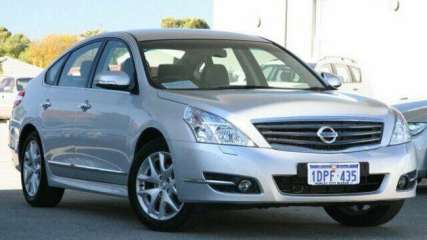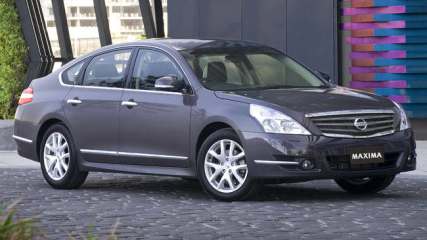Nissan Maxima 2012 Review
By Karla Pincott · 27 Mar 2012
The medium-large Nissan Maxima sedan suffered two decades of being underdone and overlooked, but the current model has a bit more to offer. It's better priced, better-equipped and - yes - better on the road, too.Sadly, while the Maxima has been improving its road manners and appeal, the market has been moving away from it. The large car segment was down 21 per cent in 2011, and has dropped 44 per cent over the past four years.The medium car market is similarly in the doldrums at 8 per cent down last year. But the remaining buyers - anybody out there? - should be giving the Maxima another look.TECHNOLOGY Nissan has always done well in the V6 department, and the Maxima range has two - the Murano-shared 3.5-litre V6 in two spec levels and the single-spec 2.5-litre tested here. The engine develops134kw of power and 228Nm of torque driving the front wheels via a constantly variable auto with a six-gear manual-shifting mode.The official fuel economy is 9.5L/100km, which - even if we hadn't logged a litre more per 100km - starts to look thirsty these days against smarter rivals like the Ford Mondeo Zetec.DESIGNIt's come a long way from the previous dowdy models, but the Maxima's design is still very much on the conservative side. It stands out a bit more now with touches of chrome bling, while there's an upmarket impression from the stylish alloys and light clusters.The interior echoes the premium bid with leather everywhere and a good-looking dash. But the foot-operated park brake seemed an overlooked relic from the old Maxima - and the lack of reach-adjustment on the steering column was at odds with the reach for better quality.Some of the plastics still feel cheap -- and we were disappointed to see part of the centre console had sprung out of alignment. We were barely able to slide a thick magazine into the miserly door pockets, but had to applaud the decent boot capacity - which is just as well, because with the rear seat not folding, the 500-odd litres you see is all you get.SAFETYIt gets six airbags, stability and traction control, anti-skid brakes with brake assist for emergency stops and brakeforce distribution to compensate for uneven loading. The current model has not been crash-tested by ANCAP, but the previoous one scored four stars and this one should do as well.VALUEThe 250 ST-L is ridiculously well-priced from $33,990, with a good standard feature list that includes Bluetooth with sterring wheel controls, six-CD audio with iPod compatibility, dual-zone climate control airconditioning, leather upholstery, powered front seats, powered side mirrors, foglights, xenon headlights, LED tail-lights, foglights and 17-in alloy wheels. Maxima is slotted into the large car category, but is more truly a large-medium. Commodore will give you more shoulder room and bigger wheelbase, but at $37,990 for the Equipe you're shelling out $4000 for the extra steel - and not really gaining any extra kit.Likewise, the Falcon dwarfs it, and while the mid-sized Mondeo is slightly shorter it offers about the same amount of room. The decider is under the bonnet.LX's 2.3-litre four-cylinder is staid but if you want a driver's car, shell out the $37,740 for the Zetec and get the torquey 149kW/300Nm turbo 2.0-litre (with better fuel economy at 8L/100km - and 187g/km CO2). Plus it offers extra equipment, including a driver's knee bag, nine-speaker audio and voice recognition. The Toyota Aurion offers a touch more room, and a lot more power and torque from the 3.5-litre V6. But for $2000 more than the Maxima it looks 20 years blander inside and out.DRIVINGIt's not a sports car - let's get that straight for a start. But it doesn't drive like a bowl of rice pudding either. A slightly brisk push through some winding road will betray barely any wallowing and very little understeer, but show it's controlled and agile for something this size.The penalty for that is feeling the bumps more over bad sections, although the ride quality overall is pretty good.The speed-sensitive steering (borrowed from the 350Z) is responsive and accurate as you climb up the speedo, but feels strangely vague at lower speeds.However, the CVT is one of the few we've met that you could happily live with. There's less annoying drone than we've heard in others, and it matches well to the peppy engine for most of the rev range.Its only falter is when you try to quickly extract a bit more for higher speed overtaking - in this case for a couple of semis that decided to close their gap - and at that stage you \start thinking you need either a proper set of decisive gears or a bit more engine capacity.VERDICTThe Maxima is a comfortable, generously-equipped and roomy sedan that drives capably and offers fantastic value for money. It's got nearly everything right - except the market timing.NISSAN MAXIMA 250 ST-LPrice: $33,990Warranty: Three-years/100,000kmResale: 65 per centService intervals: 10,000km/six monthsThirst: 9.5 litres/100km 91 RON, 226g/km CO2Safety equipment: Six airbags, ABS with EBD and BAEngine: 2.5-litre V6 petrol, 134kW/228NmTransmission: 6-speed continuously variable automatic, FWDBody: four-door sedan, seats fiveDimensions: 4850mm (L), 1795mm (W), 1485mm (H), 2775mm (WB), 1550mm/1555mm tracks front/rearWeight: 1522kgTyre size: 17 x 7.0Spare tyre: full-size steel









